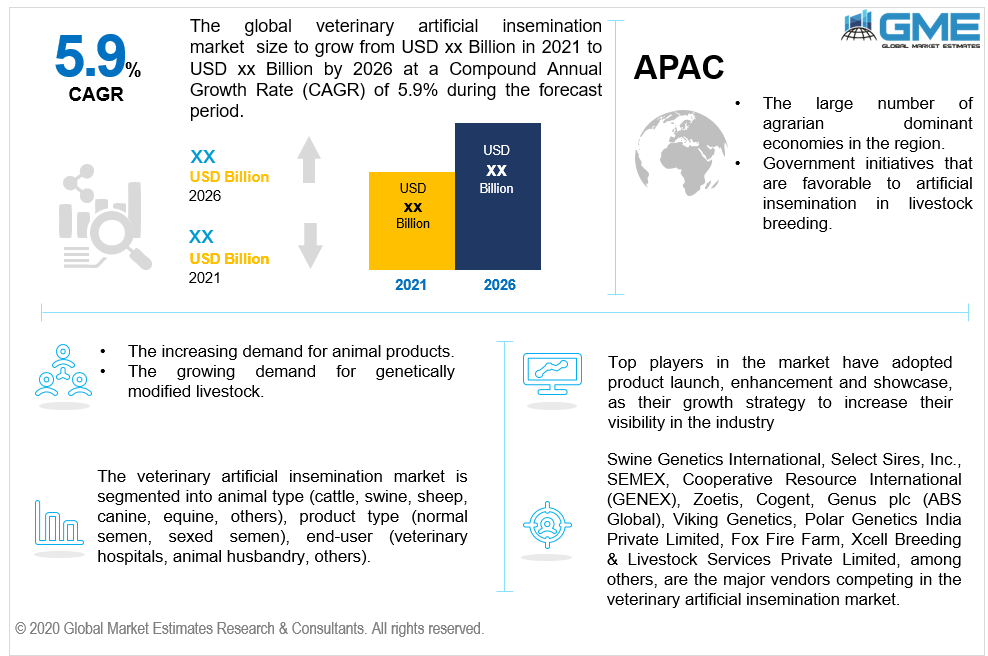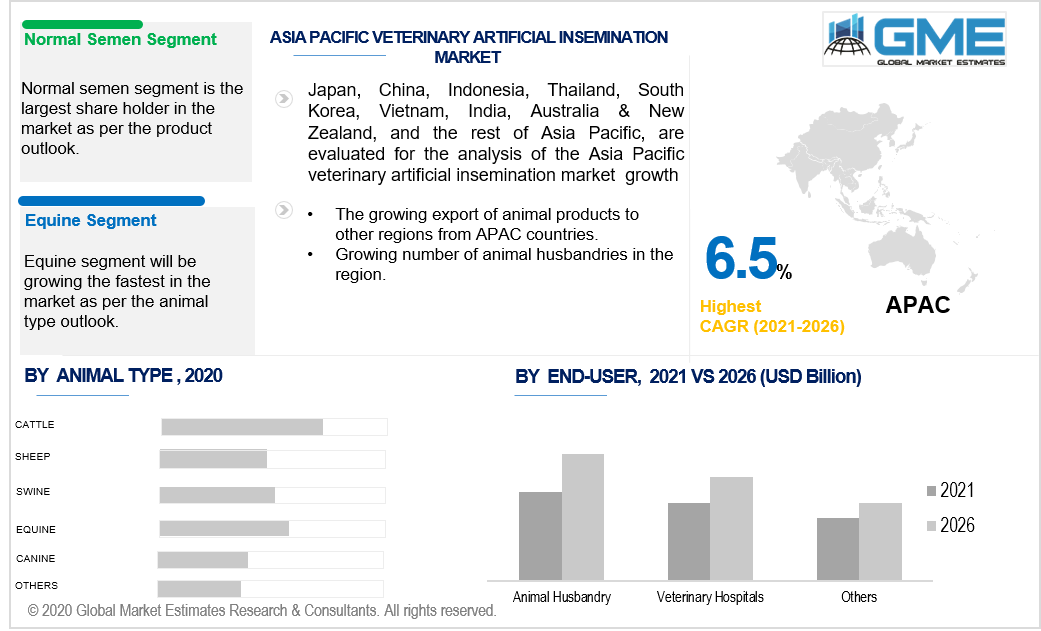
Global Veterinary Artificial Insemination Market Size, Trends, and Analysis - Forecasts To 2026 By Animal Type (Cattle, Swine, Sheep, Canine, Equine, Others), By Product Type (Normal Semen, Sexed Semen), By End-User (Veterinary Hospitals, Animal Husbandry, Others), By Region (North America, Asia Pacific, CSA, Europe, and the Middle East and Africa), End-User Landscape, Company Market Share Analysis & Competitor Analysis
Veterinary artificial insemination is used to breed cattle and other livestock using frozen semen. Artificial insemination has to be carried out at the right time during the animal’s heat cycle to attain the best results. Previously, livestock had to be monitored for heat to breed them at the appropriate time. In recent years, synchronization protocols are being implemented to bring the majority of the herd into heat cycles so that they can all be bred at the same time. Advancements in the synchronization of heat cycles among herds have made artificial insemination more feasible. Artificial insemination reduces the risks involved with animal breeding and disease transmission which has increased the demand for artificial insemination in animal husbandries. Artificial insemination allows herders to breed livestock with superior genes. In cattle herding, artificial insemination can result in female offsprings that have greater capabilities of milk production. By using semen from sires that have high fertility rates, herders can improve the conception rates and produce more calves, and can predict the qualities of the calves to a certain extent.
Artificial insemination results in a reduction of calving difficulties and weans larger calves that have better and more desirable carcasses. Artificial insemination can increase the herders’ profits and has proved to be more efficient than natural breeding. The artificial insemination process uses semen extenders that have antibiotics in them that help prevents the spread of bacterial diseases. Artificial insemination is considered to be more hygienic than natural breeding which also contributes to the reduced spread of diseases.
Farmers' needs and production requirements change as the market changes. These changes often result in certain animal breeds becoming unfeasible for farmers to raise. Artificial insemination allows farmers to continue to farm these breeds in situ. There have been no studies demonstrating that the novel coronavirus can propagate among livestock. However, pandemic-induced lockdowns have affected supply chains and have resulted in a lack of veterinary products like nutritional feed.
Governments across the world have undertaken initiatives to support animal husbandries by providing them with telephonic assistance and delivering artificial insemination services to their doorstep. The growing demand for animal products mainly due to the growing human population has also increased the demand for artificial insemination as farmers try to meet the growing demands. Artificial insemination has also effectively reduced the prices of bulls. Artificial insemination is also lucrative to farmers as calf prices are increasing and have contributed to the growth of the artificial insemination market. It allows breeders to breed genetically superior offsprings with desirable traits.
Animals cannot propagate COVID-19 to humans, according to the COVID-19 pandemic's evidence. The global supply chain has been disrupted by the coronavirus pandemic, resulting in a lack of animal health items such as organic feed. As a result, it may be made up of animal feed, affecting reproductive ability.

During the forecast timeframe, the cattle segment is projected to have the largest market share. Artificial insemination allows herders to breed cattle with increased milk production and better carcass traits with reduced risks compared to natural breeding. Rising consumption of meat and growing demand for animal products have also contributed to the growth of the cattle artificial insemination market. The equine segment is expected to register the fastest growth during the forecast period. Artificial insemination reduces the risks involved with natural breeding as they are more hygienic and reduces the risk of disease contraction during breeding. Artificial insemination is heavily used to breed endangered species. During the forecast era, these trends are likely to boost demand for equine artificial insemination.
Based on the various artificial insemination products, the artificial insemination market can be segmented into normal semen and sexed semen. Normal semen is expected to hold the lion’s share of the market during the forecast period. Normal semen have higher conception rates and are cheaper than sexed semen which are the major factors for the large demand for normal semen. Sexed semen is expected to register the fastest growth rate during the forecast period. Sexed semen is a relatively newer innovation and has proven to be reliable with regards to the predicted gender of the offspring.
Based on the various end-users of artificial insemination, the veterinary artificial insemination market can be segmented into veterinary hospitals, animal husbandry, and others. The animal husbandry segment is expected to hold the dominant share of the market during the forecast period. Growing demand for meat and animal products has resulted in large-scale adoption of artificial insemination among both small and large animal husbandries across the globe. Government initiatives are also becoming increasingly favorable to the adoption of the artificial insemination process which has also contributed to the growth of this segment.

The APAC region is expected to hold the dominant share of the veterinary artificial insemination market. The region has a large number of agrarian economies. Government initiatives that favor cattle and livestock herders are one of the major reasons for the dominance of this region. Growing demand for animal products such as dairy and meat is another major contributor to the high growth of this region. India held a share of 24% of the veterinary artificial insemination market. China is also expected to have a high demand for artificial insemination as they have the third-largest livestock inventory and are increasingly using artificial insemination to improve their livestock. The Central and South America region is expected to grow at the fastest rate during the forecast period. Countries like Brazil are increasing the use of artificial insemination to improve cattle output. Central and South American countries are also increasingly adopting sexed semen-based artificial insemination. These trends, along with the government funding in the region, are expected to boost demand for artificial insemination in the region.
Swine Genetics International, SEMEX, Zoetis, Genus PLC. (ABS Global),Polar Genetics India Private Limited, Xcell Breeding & Livestock Services Private Limited, Select Sires, Inc., Cooperative Resource International (GENEX), Cogent, Viking Genetics, Fox Fire Farm, among others, are the major vendors competing in the veterinary artificial insemination market.
Please note: This is not an exhaustive list of companies profiled in the report.
In 2017, Genus PLC launched Genus IntelliGen Technologies a modern technology unit that develops sexed bovine genetics without exposing cells to the high temperatures, electric currents, and shear forces found in other sexed semen processes.
We value your investment and offer free customization with every report to fulfil your exact research needs.
The Global Veterinary Artificial Insemination Market has been studied from the year 2019 till 2026. However, the CAGR provided in the report is from the year 2021 to 2026. The research methodology involved three stages: Desk research, Primary research, and Analysis & Output from the entire research process.

The desk research involved a robust background study which meant referring to paid and unpaid databases to understand the market dynamics; mapping contracts from press releases; identifying the key players in the market, studying their product portfolio, competition level, annual reports/SEC filings & investor presentations; and learning the demand and supply-side analysis for the Veterinary Artificial Insemination Market.

The primary research activity included telephonic conversations with more than 50 tier 1 industry consultants, distributors, and end-use product manufacturers.

Finally, based on the above thorough research process, an in-depth analysis was carried out considering the following aspects: market attractiveness, current & future market trends, market share analysis, SWOT analysis of the company and customer analytics.

Tailor made solutions just for you
80% of our clients seek made-to-order reports. How do you want us to tailor yours?
OUR CLIENTS